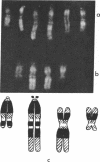Abstract
Man-mouse and man-Syrian hamster somatic hybrid cell lines were prepared by fusion of mouse A9 or hamster TG2 cells, which are deficient in hypoxanthine-guanine phosphoribosyl transferase, with cells of a diploid fibroblastic strain, KOP-1, derived from a woman heterozygous for an X-autosome translocation. 61 clones were derived in nonselective medium and 85 sublines of these were derived in selective media: 53 in hypoxanthine-aminopterine-thymidine and 32 in 8-azaguanine. All three human X-linked markers studied, i.e., hypoxanthineguanine phosphoribosyl transferase (EC 2.4.2.8), glucose-6-phosphate dehydrogenase (EC 1.1.1.49), and phosphoglycerate kinase (EC 2.7.2.3), were present together, or absent together, in most of these clones and sublines. However, loss or retention of only phosphoglycerate kinase was occasionally observed, even in the absence of selective growth, while no evidence of separation of hypoxanthine-guanine phosphoribosyl transferase from glucose-6-phosphate dehydrogenase occurred. Cytological examination of eight man-hamster clonal lines by the quinacrine fluorescent technique showed that human phosphoglycerate kinase was only present when the translocation chromosome carrying most of the long arm of the X chromosome was present. The presence of human glucose-6-phosphate dehydrogenase and hypoxanthine-guanine phosphoribosyl transferase was not related to the presence or absence of this chromosome, but appeared to be correlated with the presence of the other translocation chromosome.
Keywords: mouse, hamster, human X-linked markers
Full text
PDF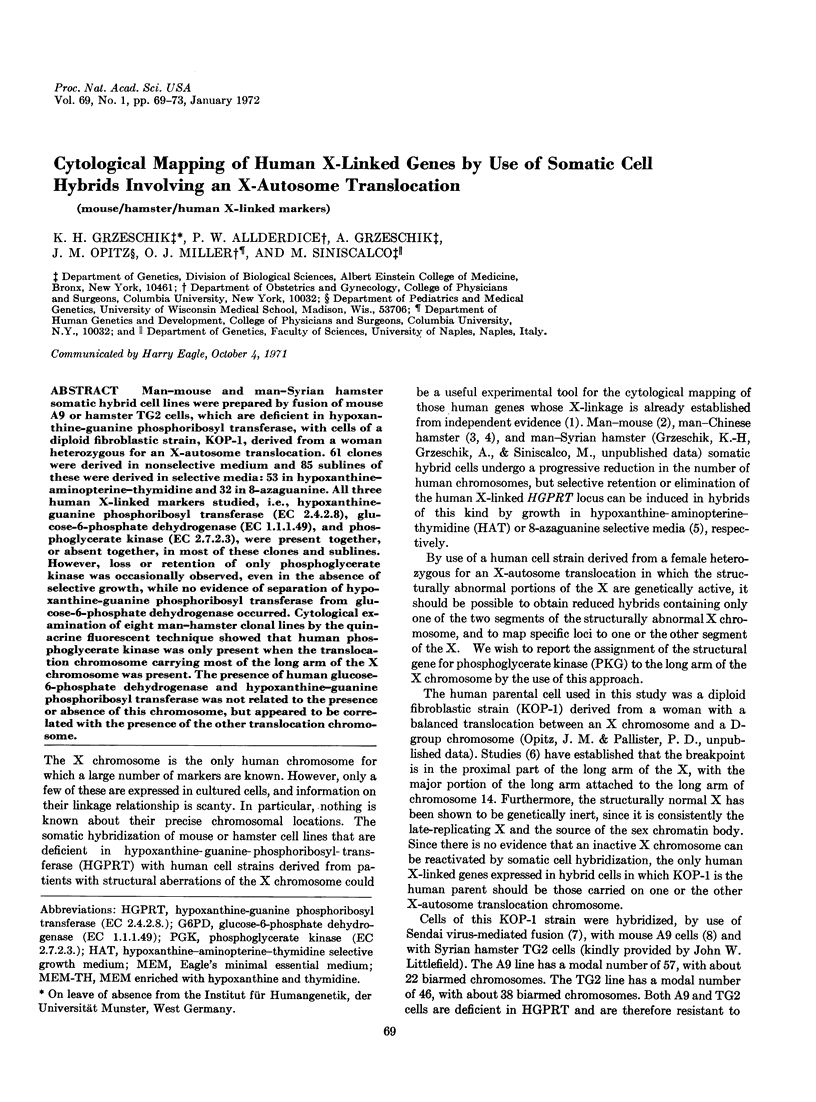
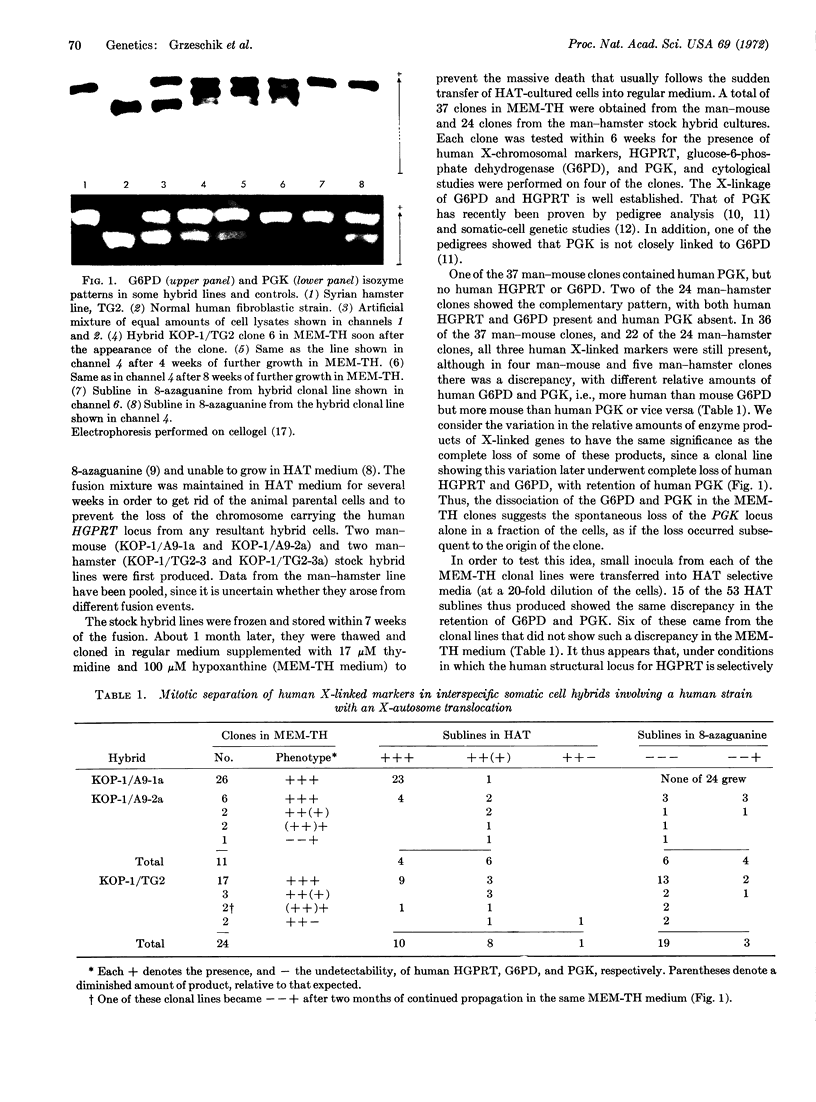
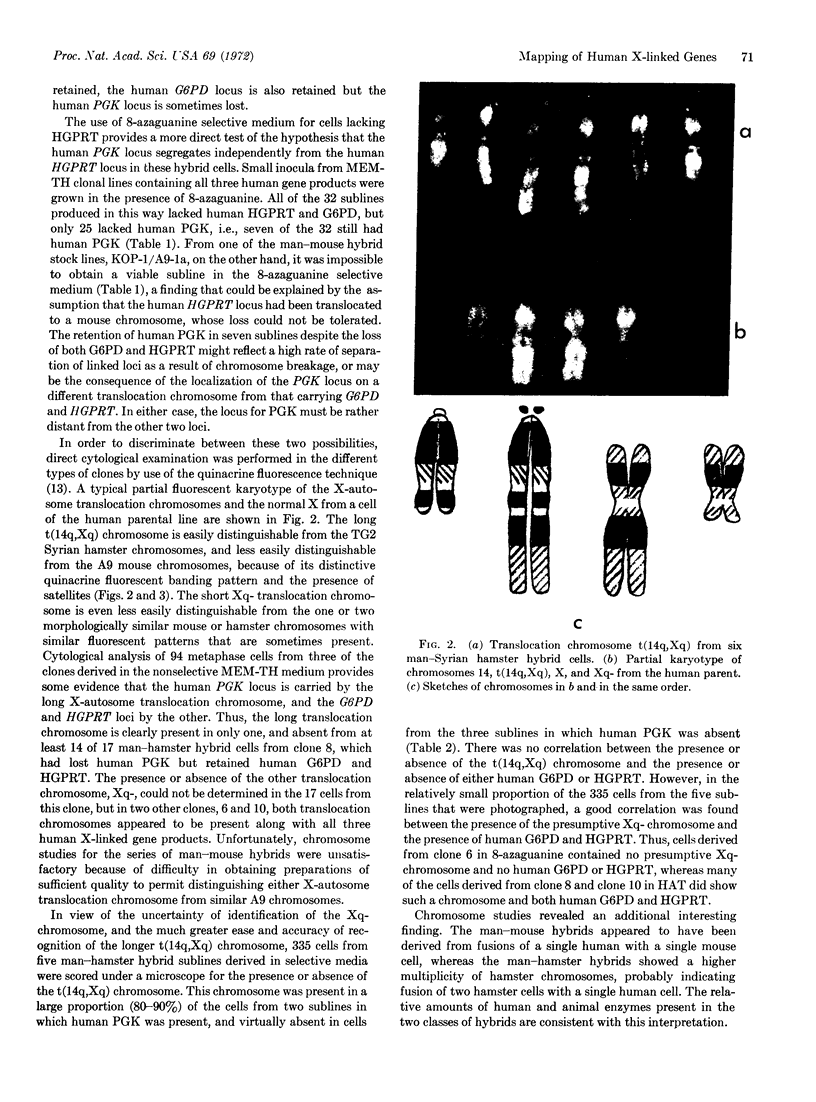
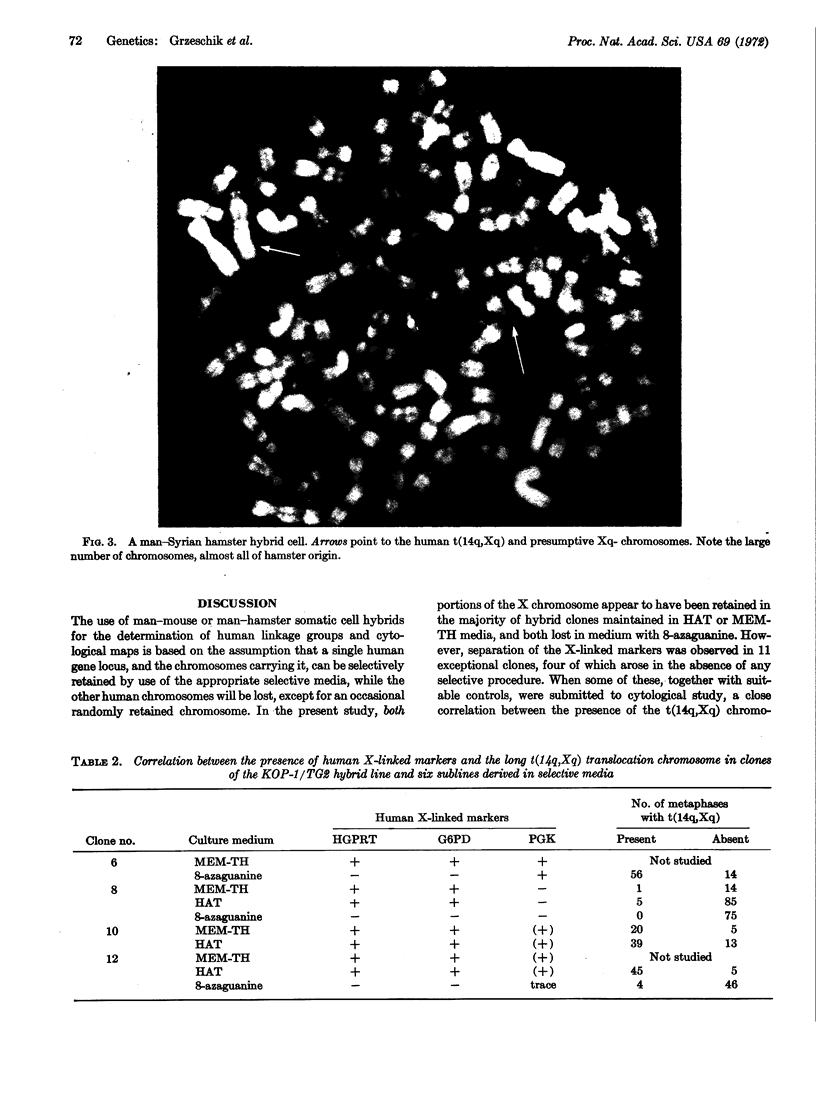
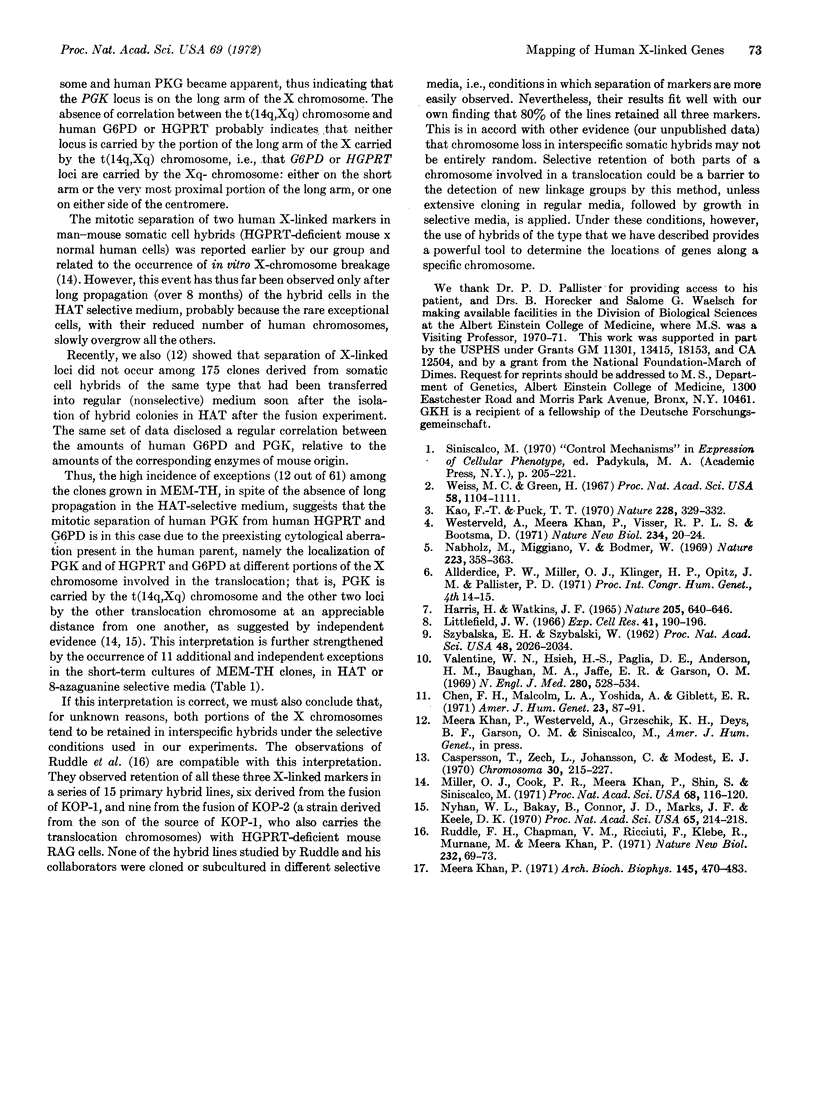
Images in this article
Selected References
These references are in PubMed. This may not be the complete list of references from this article.
- Caspersson T., Zech L., Johansson C., Modest E. J. Identification of human chromosomes by DNA-binding fluorescent agents. Chromosoma. 1970;30(2):215–227. doi: 10.1007/BF00282002. [DOI] [PubMed] [Google Scholar]
- Chen S. H., Malcolm L. A., Yoshida A., Giblett E. R. Phosphoglycerate kinase: an X-linked polymorphism in man. Am J Hum Genet. 1971 Jan;23(1):87–91. [PMC free article] [PubMed] [Google Scholar]
- HARRIS H., WATKINS J. F. HYBRID CELLS DERIVED FROM MOUSE AND MAN: ARTIFICIAL HETEROKARYONS OF MAMMALIAN CELLS FROM DIFFERENT SPECIES. Nature. 1965 Feb 13;205:640–646. doi: 10.1038/205640a0. [DOI] [PubMed] [Google Scholar]
- Káo F. T., Puck T. T. Genetics of somatic mammalian cells: linkage studies with human-Chinese hamster cell hybrids. Nature. 1970 Oct 24;228(5269):329–332. doi: 10.1038/228329a0. [DOI] [PubMed] [Google Scholar]
- Littlefield J. W. The use of drug-resistant markers to study the hybridization of mouse fibroblasts. Exp Cell Res. 1966 Jan;41(1):190–196. doi: 10.1016/0014-4827(66)90558-1. [DOI] [PubMed] [Google Scholar]
- Meera Khan P. Enzyme electrophoresis on cellulose acetate gel: zymogram patterns in mgh-mouse and man--Chinese hamster somatic cell hybrids. Arch Biochem Biophys. 1971 Aug;145(2):470–483. doi: 10.1016/s0003-9861(71)80007-3. [DOI] [PubMed] [Google Scholar]
- Miller O. J., Cook P. R., Meera Khan P., Shin S., Siniscalco M. Mitotic separation of two human X-linked genes in man--mouse somatic cell hybrids. Proc Natl Acad Sci U S A. 1971 Jan;68(1):116–120. doi: 10.1073/pnas.68.1.116. [DOI] [PMC free article] [PubMed] [Google Scholar]
- Nabholz M., Miggiano V., Bodmer W. Genetic analysis with human--mouse somatic cell hybrids. Nature. 1969 Jul 26;223(5204):358–363. doi: 10.1038/223358a0. [DOI] [PubMed] [Google Scholar]
- Nyhan W. L., Bakay B., Connor J. D., Marks J. F., Keele D. K. Hemizygous expression of glucose-6-phosphate dehydrogenase in erythrocytes of heterozygotes for the Lesch-Nyhan syndrome. Proc Natl Acad Sci U S A. 1970 Jan;65(1):214–218. doi: 10.1073/pnas.65.1.214. [DOI] [PMC free article] [PubMed] [Google Scholar]
- Ruddle F. H., Chapman V. M., Ricciuti F., Murnane M., Klebe R., Meera Khan P. Linkage relationships of seventeen human gene loci as determined by man--mouse somatic cell hybrids. Nat New Biol. 1971 Jul 21;232(29):69–73. doi: 10.1038/newbio232069a0. [DOI] [PubMed] [Google Scholar]
- SZYBALSKA E. H., SZYBALSKI W. Genetics of human cess line. IV. DNA-mediated heritable transformation of a biochemical trait. Proc Natl Acad Sci U S A. 1962 Dec 15;48:2026–2034. doi: 10.1073/pnas.48.12.2026. [DOI] [PMC free article] [PubMed] [Google Scholar]
- Valentine W. N., Hsieh H. S., Paglia D. E., Anderson H. M., Baughan M. A., Jaffé E. R., Garson O. M. Hereditary hemolytic anemia associated with phosphoglycerate kinase deficiency in erythrocytes and leukocytes. A probable X-chromosome-linked syndrome. N Engl J Med. 1969 Mar 6;280(10):528–534. doi: 10.1056/NEJM196903062801003. [DOI] [PubMed] [Google Scholar]
- Weiss M. C., Green H. Human-mouse hybrid cell lines containing partial complements of human chromosomes and functioning human genes. Proc Natl Acad Sci U S A. 1967 Sep;58(3):1104–1111. doi: 10.1073/pnas.58.3.1104. [DOI] [PMC free article] [PubMed] [Google Scholar]
- Westerveld A., Visser R. P., Meera Khan P., Bootsma D. Loss of human genetic markers in man--Chinese hamster somatic cell hybrids. Nat New Biol. 1971 Nov 3;234(44):20–24. doi: 10.1038/newbio234020a0. [DOI] [PubMed] [Google Scholar]




